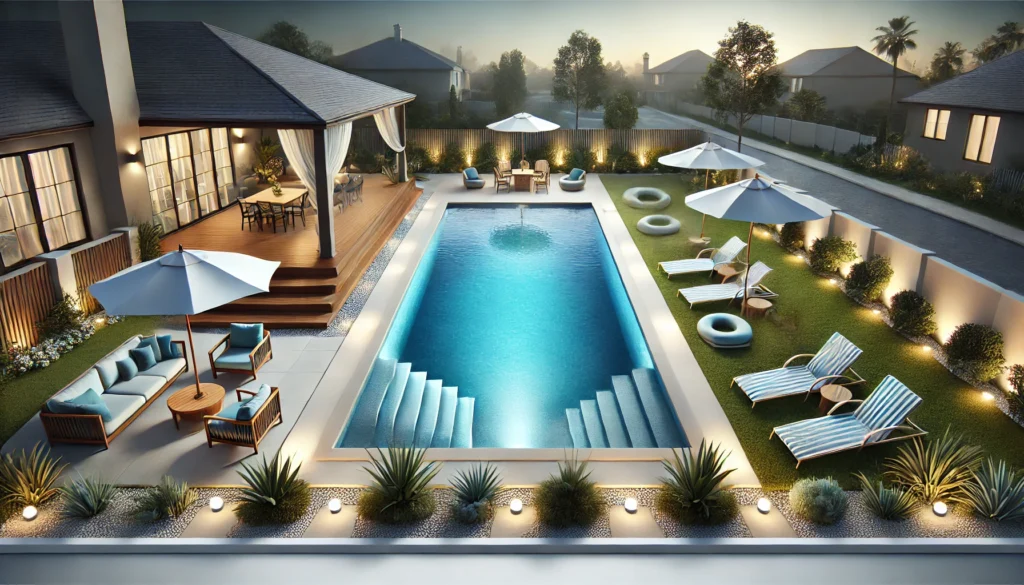A swimming pool can transform your home into a private oasis of relaxation and fun. Whether you’re dreaming of a place to unwind after a long day, entertain family and friends, or get a great workout, adding a swimming pool to your property can enhance your lifestyle and increase your home’s value. This comprehensive guide will help you navigate the process of choosing, installing, and maintaining a swimming pool to ensure you get the most out of your investment.

Why Install a Swimming Pool?
- Enhance Your Lifestyle
- A swimming pool offers a private retreat for relaxation and recreation. It provides a space for family bonding, social gatherings, and a fun way to stay active.
- Increase Property Value
- High-quality, well-maintained swimming pools can boost the value of your home, making it more attractive to potential buyers.
- Stay Fit
- Swimming is a low-impact, full-body workout that’s excellent for cardiovascular health and building strength and endurance.
Types of Swimming Pools
- In-Ground Pools
- Concrete Pools: Customizable and durable, these pools can be shaped to fit any design. They are often more expensive but offer the highest level of customization.
- Fiberglass Pools: Pre-manufactured and installed in one piece, these pools are quicker to install and require less maintenance than concrete pools.
- Vinyl Liner Pools: These pools use a vinyl liner over a steel or polymer frame. They are more affordable but require liner replacement every 5-9 years.
- Above-Ground Pools
- Metal Frame Pools: Affordable and easy to set up, these pools are available in various sizes and shapes. They’re ideal for those with a smaller budget or limited space.
- Inflatable Pools: Quick to set up and store, these pools are perfect for temporary use or smaller backyards.
Planning Your Swimming Pool

- Determine Your Budget
- Costs: Include not only the cost of the pool itself but also installation, landscaping, fencing, and ongoing maintenance. Be sure to set aside funds for unexpected expenses.
- Choose the Right Location
- Sunlight: Pools should be placed in a sunny spot to keep the water warm and reduce heating costs.
- Accessibility: Ensure the pool is easily accessible from your home and consider its proximity to utilities and any potential obstacles.
- Design Your Pool
- Shape and Size: Choose a shape and size that complements your backyard and meets your needs. Common shapes include rectangular, kidney-shaped, and freeform.
- Features: Consider adding features like waterfalls, spas, lighting, and slides to enhance your pool experience.
- Check Local Regulations
- Permits: Obtain necessary permits and adhere to local building codes and zoning laws. Regulations may include pool fencing, safety requirements, and property lines.
Installation Process
- Site Preparation
- Excavation: The area where the pool will be installed is excavated to the required depth and shape.
- Base and Walls: For in-ground pools, a base is prepared, and the pool walls are constructed. For above-ground pools, a level surface is created.
- Pool Installation
- In-Ground Pools: Concrete is poured, or a fiberglass or vinyl liner is installed. Plumbing and electrical systems are set up, and the pool is filled with water.
- Above-Ground Pools: The pool frame is assembled, the liner is installed, and the pool is filled with water.
- Finishing Touches
- Decking and Landscaping: Add decking around the pool area for a polished look. Landscaping can enhance the pool’s appearance and provide privacy.
- Safety Features: Install fencing, pool covers, and alarms to ensure safety, especially if you have young children.
Maintenance Tips
- Regular Cleaning
- Skimming: Remove leaves and debris from the surface of the pool regularly using a skimmer net.
- Brushing: Brush the pool walls and floor to prevent algae buildup.
- Vacuuming: Use a pool vacuum to clean the bottom of the pool.
- Water Chemistry
- Testing: Regularly test the pool water for pH, chlorine levels, and alkalinity. Adjust as needed to keep the water balanced and safe.
- Shocking: Periodically shock the pool with chlorine to kill bacteria and maintain water clarity.
- Filter and Pump Maintenance
- Cleaning: Clean the pool filter regularly according to the manufacturer’s instructions.
- Inspection: Check the pump and filter for any issues and ensure they are functioning properly.
- Winterizing
- Covering: Use a pool cover to protect your pool during the winter months.
- Draining: Drain the water below the skimmer and return lines to prevent freezing and damage.
Common Mistakes to Avoid
- Underestimating Costs
- Ensure your budget covers all aspects of pool ownership, including installation, maintenance, and potential repairs.
- Neglecting Safety
- Install appropriate safety features and educate family members about pool safety to prevent accidents.
- Ignoring Maintenance
- Regular maintenance is crucial for keeping your pool in good condition and ensuring clean, safe water.
- Choosing the Wrong Contractor
- Work with reputable contractors who have experience with pool installation to avoid potential issues.
Conclusion

Installing a swimming pool is a significant investment that can provide years of enjoyment and relaxation. By carefully planning your project, choosing the right type of pool, and staying on top of maintenance, you can create a stunning and functional addition to your home.

